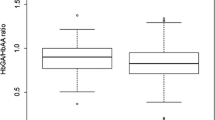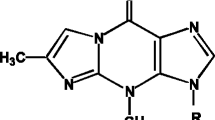Abstract
The aim of this study was to assess the relationship between bulky DNA adducts in white blood cells (WBC) and lifestyle factors in a sample from the Spanish cohort of the European Prospective Investigation into Cancer and Nutrition (EPIC). 296 subjects aged between 35 and 64 years, from five regions, were included. Food intake was estimated with a computerized version of dietary history questionnaire. Daily intake of polycyclic aromatic hydrocarbons (PAH) was estimated using a database with information on food content of potential carcinogens. Data on lifestyle and health factors were collected and DNA adducts measured using the nuclease P1 32P-postlabelling technique. Geometric means of adducts were similar for men and women (4.11/109 and 3.94/109 nucleotides, respectively). Highest levels of adduct were observed in non-smokers and non-occupationally exposed. Meat intake, oils and fats were associated with higher levels of adducts, but all non-statistically significant. Higher intakes of calcium, sodium and phosphorus were associated with lower adducts levels. Summarising, our study shows that bulky adducts measured by 32P-postlabelling in DNA from WBC do not correlate with the usual diet of healthy Spanish adults. Although it has been proposed that diet be the main source of PAH in nonsmokers without occupational exposure, DNA adducts do not seem to be suitable biomarkers of dietary PAH in general population.
Similar content being viewed by others
Abbreviations
- WBC:
-
White blood cells
- EPIC:
-
European Prospective Investigation into Cancer and Nutrition
- PAH:
-
Polycyclic aromatic hydrocarbons
- B[a]P:
-
Benzo[a]pyrene
- BPDE:
-
Benzopyrene-diol-epoxide
- RAL:
-
Relative adduct labelling
- DH:
-
Dietary history questionnaire
- 24-HDR:
-
24-h dietary recall
- CI:
-
Confidence intervals
- LRT:
-
Likelihood ratio test
References
Hemminki K, Koskinen M, Rajaniemi H, Zhao C (2000) DNA adducts, mutations, and cancer 2000. Regul Toxicol Pharmacol 32:264–275
Poirier MC, Santella RM, Weston A (2000) Carcinogen macromolecular adducts and their measurement. Carcinogenesis 21:353–359
Palli D, Vineis P, Russo A, Berrino F et al (2000) Diet, metabolic polymorphisms and DNA adducts: the EPIC-Italy cross-sectional study. Int J Cancer 87:444–451
Bostrom CE, Gerde P, Hanberg A, Jernstrom B et al (2002) Cancer risk assessment, indicators, and guidelines for polycyclic aromatic hydrocarbons in the ambient air. Environ Health Perspect 110(Suppl 3):451–488
Lodovici M, Luceri C, Guglielmi F, Bacci C et al (2004) Benzo[a]pyrene diolepoxide [BPDE]-DNA adduct levels in leukocytes of smokers in relation to polymorphism of CYP1A1, GSTM1, GSTP1, GSTT1, and mEH. Cancer Epidemiol Biomarkers Prev 13:1342–1348
Palli D, Masala G, Vineis P, Garte S et al (2003) Biomarkers of dietary intake of micronutrients modulate DNA adduct levels in healthy adults. Carcinogenesis 24:739–746
Peluso M, Munnia A, Hoek G, Krzyzanowski M et al (2005) DNA adducts and lung cancer risk: a prospective study. Cancer Res 65:8042–8048
Bak H, Autrup H, Thomsen BL, Tjonneland A et al (2006) Bulky DNA adducts as risk indicator of lung cancer in a Danish case-cohort study. Int J Cancer 118:1618–1622
Peluso M, Neri M, Margarino G, Mereu C et al (2004) Comparison of DNA adduct levels in nasal mucosa, lymphocytes and bronchial mucosa of cigarette smokers and interaction with metabolic gene polymorphisms. Carcinogenesis 25:2459–2465
Hainaut P, Pfeifer GP (2001) Patterns of p53 G → T transversions in lung cancers reflect the primary mutagenic signature of DNA-damage by tobacco smoke. Carcinogenesis 22:367–374
Ibanez R, Agudo A, Berenguer A, Jakszyn P et al (2005) Dietary intake of polycyclic aromatic hydrocarbons in a Spanish population. J Food Prot 68:2190–2195
Sinha R, Kulldorff M, Gunter MJ, Strickland P, Rothman N (2005) Dietary benzo[a]pyrene intake and risk of colorectal adenoma. Cancer Epidemiol Biomarkers Prev 14:2030–2034
Palli D, Masala G, Peluso M, Gaspari L et al (2004) The effects of diet on DNA bulky adduct levels are strongly modified by GSTM1 genotype: a study on 634 subjects. Carcinogenesis 25:577–584
Bingham S, Riboli E (2004) Diet and cancer—the European Prospective Investigation into Cancer and Nutrition. Nat Rev Cancer 4:206–215
Gonzalez CA, Navarro C, Martinez C, Quiros JR et al (2004) The European prospective investigation about cancer and nutrition [EPIC]. Rev Esp Salud Publica 78:167–176
Instituto Nacional de Estadísrtica [INE] (2003). http://www.ine.es. Accessed 21 Nov 2007
Reddy MV, Randerath K (1990) A comparison of DNA adduct formation in white blood cells and internal organs of mice exposed to benzo[a]pyrene, dibenzo[c, g]carbazole, safrole and cigarette smoke condensate. Mutat Res 241:37–48
Peluso M, Castegnaro M, Malaveille C, Friesen M et al (1991) 32P Postlabelling analysis of urinary mutagens from smokers of black tobacco implicates 2-amino-1-methyl-6-phenylimidazo[4, 5-b]pyridine [PhIP] as a major DNA-damaging agent. Carcinogenesis 12:713–717
Gupta RC (1993) 32P-Postlabelling analysis of bulky aromatic adducts. In: Phillips DH, Castegnaro M, Bartsch H (eds) Postlabelling methods for detection of DNA adducts. IARC Scientific Publication No. 124. International Agency for Research on Cancer, Lyon, pp 11–23
Phillips DH, Castegnaro M, Autrup H, Nielsen PS et al (1999) Standardisation and validation of DNA adduct postlabelling methods: report of interlaboratory trials and production of recommended protocols. Mutagenesis 14:301–315
Reichert WL, Stein JE, French B, Goodwin P, Varanasi U (1992) Storage phosphor imaging technique for detection and quantitation of DNA adducts measured by the 32P-postlabeling assay. Carcinogenesis 13:1475–1479
Reddy MV, Randerath K (1986) Nuclease P1-mediated enhancement of sensitivity of 32P-postlabeling test for structurally diverse DNA adducts. Carcinogenesis 7:1543–1551
Beach AC, Gupta RC (1992) Human biomonitoring and the 32P-postlabeling assay. Carcinogenesis 13:1053–1074
EPIC Group of Spain (1997) Relative validity and reproducibility of a diet history questionnaire in Spain I. Foods. EPIC Group of Spain. European Prospective Investigation into Cancer and Nutrition. Int J Epidemiol 26(Suppl 1):S91–S99
EPIC Group of Spain (1997) Relative validity and reproducibility of a diet history questionnaire in Spain II. Nutrients. EPIC Group of Spain. European Prospective Investigation into Cancer and Nutrition. Int J Epidemiol 26(Suppl 1):S100–S109
Slimani N, Farran A, Torrent M et al (1996) European Prospective Investigation into Cancer and Nutrition [EPIC]: Food Composition Tables—Spain, 2nd edn. International Agency for Research on Cancer [IARC], Lyon
Jakszyn P, Agudo A, Ibanez R, Garcia-Closas R et al (2004) Development of a food database of nitrosamines, heterocyclic amines, and polycyclic aromatic hydrocarbons. J Nutr 134:2011–2014
Riboli E, Hunt KJ, Slimani N, Ferrari P et al (2002) European Prospective Investigation into Cancer and Nutrition [EPIC]: study populations and data collection. Public Health Nutrition 5:1113–1124
Armitage P, Berry G (1994) Statistical methods in medical research, 3rd edn. Blackwell, Oxford
Godschalk RW, Maas LM, Van Zandwijk N, van ‘t Veer LJ et al (1998) Differences in aromatic-DNA adduct levels between alveolar macrophages and subpopulations of white blood cells from smokers. Carcinogenesis 19:819–825
Godschalk RW, Van Schooten FJ, Bartsch H (2003) A critical evaluation of DNA adducts as biological markers for human exposure to polycyclic aromatic compounds. J Biochem Mol Biol 36:1–11
Arif JM, Dresler C, Clapper ML, Gairola CG et al (2005) Lung DNA adducts detected in human smokers are unrelated to typical polyaromatic carcinogens. Chem Res Toxicol 19:295–299
Peluso M, Merlo F, Munnia A, Valerio F et al (1998) 32P-postlabeling detection of aromatic adducts in the white blood cell DNA of nonsmoking police officers. Cancer Epidemiol Biomarkers Prev 7:3–11
Eder E (1999) Intraindividual variations of DNA adduct levels in humans. Mutat Res 424:249–261
Schoket B (1999) DNA damage in humans exposed to environmental and dietary polycyclic aromatic hydrocarbons. Mutat Res 424:143–153
Grzybowska E, Hemminki K, Szeliga J, Chorazy M (1993) Seasonal variation of aromatic DNA adducts in human lymphocytes and granulocytes. Carcinogenesis 14:2523–2526
Sinha R, Peters U, Cross AJ, Kulldorff M, Rothman N, Hayes RB et al (2005) Meat, meat cooking methods and preservation, and risk for colorectal adenoma. Cancer Res 65:8034–8041
Godschalk RW, Feldker DE, Borm PJ, Wouters EF, van Schooten FJ (2002) Body mass index modulates aromatic DNA adduct levels and their persistence in smokers. Cancer Epidemiol Biomarkers Prev 11:790–793
Block G (1992) The data support a role for antioxidants in reducing cancer risk. Nutr Rev 50:207–213
Izzotti A, Balansky RM, Blagoeva PM, Mircheva ZI et al (1998) DNA alterations in rat organs after chronic exposure to cigarette smoking and/or ethanol ingestion. FASEB J 12:753–758
Gammon MD, Sagiv SK, Eng SM, Shantakumar S et al (2004) Polycyclic aromatic hydrocarbon-DNA adducts and breast cancer: a pooled analysis. Arch Environ Health 59:640–649
Shantakumar S, Gammon MD, Eng SM, Sagiv SK et al (2005) Residential environmental exposures and other characteristics associated with detectable PAH-DNA adducts in peripheral mononuclear cells in a population-based sample of adult females. J Expo Anal Environ Epidemiol 15:482–490
Sharma RA, Farmer PB (2004) Biological relevance of adduct detection to the chemoprevention of cancer. Clin Cancer Res 10:4901–4912
Nelson M, Bingham SA (1997) Assessment of food consumption and nutrient intake. In: Margetts BM, Nelson M (eds) Design concepts in nutritional epidemiology. Oxford University Press, Oxford
Gyorffy E, Anna L, Gyori Z, Segesdi J et al (2004) DNA adducts in tumour, normal peripheral lung and bronchus, and peripheral blood lymphocytes from smoking and non-smoking lung cancer patients: correlations between tissues and detection by 32P-postlabelling and immunoassay. Carcinogenesis 25:1201–1209
Ibáñez R, Munnia A, Agudo A, Berenguer A et al (2005) Reliability of bulky DNA adducts measurement by the nuclease P1 32P-post-labelling technique. Biomarkers 10:1–9
Aranceta J, Perez C, Eguileor I, Gonzalez de Goldeano L et al. (1990) Nutritional survey. Technical documents of public health, series A, No. 9. Government of the Basque Country, Vitoria
Mataix J, Llopis J, Martinez de Victoria E, Montellano MA et al (1999) Evaluation of the Nutritional Status in the Autonomous Community of Andalucia. Public Health Service and Institute of Nutrition and Food Technology of the University of Granada, Granada
Acknowledgments
The project received financial support from the Health Research Fund (FIS, 02/0652) of the Spanish Ministry of Health, Red Temática de Investigación Cooperativa de Centros de Cáncer (C03/10) and the Environmental Cancer Risk, Nutrition and Individual Susceptibility (ECNIS, FP6, FOOD-CT-2005-513 943), and it was partially supported by the Associazione Italiana per la Ricerca sul Cancro (AIRC). All the authors have had no involvements that might raise the question of bias in the work reported or in the conclusions, implications or opinions stated.
Author information
Authors and Affiliations
Corresponding author
Rights and permissions
About this article
Cite this article
Ibáñez, R., Peluso, M., Munnia, A. et al. Aromatic DNA adducts in relation to dietary and other lifestyle factors in Spanish adults. Eur Food Res Technol 229, 549–559 (2009). https://doi.org/10.1007/s00217-009-1089-x
Received:
Revised:
Accepted:
Published:
Issue Date:
DOI: https://doi.org/10.1007/s00217-009-1089-x




